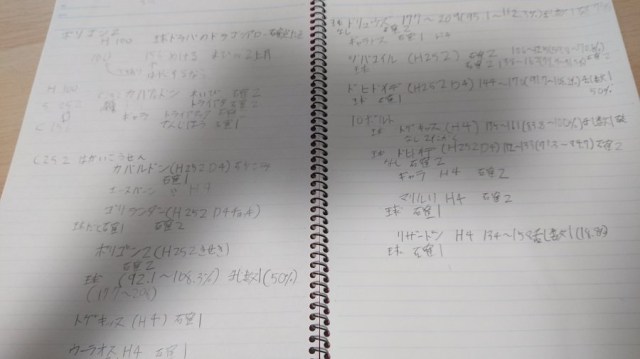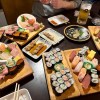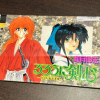
Scholarly approach makes it look like he’s been hitting the books, but really he’s just trying to catch ‘em all.
Japanese schools are known for their high academic standards, but that doesn’t mean that kids are getting graded on worksheets and reports every day. If anything, Japanese curriculums tend to put more weight on test scores, making putting in extra hours hitting the books before exams, and taking things a little easier otherwise, a common aspect of kids’ study habits.
So Japanese high school student and Twitter user @Ariagemu’s mom was impressed when she took a peek at her son’s notebook and saw it filled with detailed, neatly arranged, freshly written notes, even though there wasn’t any need to be cramming for a test right then.
▼ My mom: “Studying so hard even though you don’t have a test coming up soon. How industrious!”
Me: “……”🤔
All those numbers and equations suggest some sort of technical subject, and the scholarly atmosphere is further added to by the presence of numerous words written in katakana, the type of Japanese script used for writing foreign loanwords, which show up frequently in chemistry and other scientific fields. The words on the pages of the notebook aren’t common vocabulary words among Japanese speakers, either, no doubt making Mom even more impressed at the advanced terminology her son was working with.
So let’s try to learn from @Ariagemu’s example and familiarize ourselves with some of the words he’s written, like rizadon. Is that some sort of specialized unit of measurement, or a newly discovered element that’s just been added to the periodic table?
Nope, it’s a Pokémon.
▼ Rizadon (リザードン in katakana)
リザードン
— ポケモン図鑑 (@pkzkn) July 6, 2020
本気で怒ったリザードンのシッポの先の炎は青白く燃え上がる。 pic.twitter.com/3p42e7BRA4
Specifically, it’s Charizard, the second-stage evolution of starter Pokémon Charmander. As we’ve mentioned before, most Pokémon species have different names in the Japanese-language versions of the games and anime. However, in addition to being used for loanwords, katakana is also used when writing fictitious names, and what @Ariagemu’s mom saw wasn’t his school notebook, but his memos for how best to catch and evolve Pocket Monsters in Pokémon Sword and Shield. Some of the other equations are for Hippodon (Kaburadon in Japan), Rillaboom (Goriranda), and Urshifu (Uraosu).
Other Twitter users were quick to chuckle along as @Ariagemu inadvertently parlayed Poké-passion into parental praise, leaving comments like:
“I had a notebook just like this when I was in junior high.”
“I consider Pokémon to be part of my compulsory education.”
“I test myself on it every day!”
“Are there Pokémon questions on the national college entrance exam?”
“Figuring out those calculations will definitely improve your math skills.”
“You have to be a genius to remember what each species name, type, and special skill are.”
“I’ve heard that this sort of thing really improves kids’ memories if they do it from a young age.”
As pointed out by the last few commenters, even if it’s something he’s doing as an offshoot of entertainment, compiling, examining, and organizing all that data is also probably helping @Ariagemu sharpen his analytical and communication skills. So really, his mom’s respect for his industriousness isn’t entirely misplaced, and we can think of at least two other moms who’d be very proud of his commitment to hand-written video game records.
Source: Twitter/@Ariagemu via Jin
Top image: Twitter/@Ariagemu
● Want to hear about SoraNews24’s latest articles as soon as they’re published? Follow us on Facebook and Twitter!

 New starter Pokémon and setting for upcoming Pokémon Sun and Moon games revealed 【Video】
New starter Pokémon and setting for upcoming Pokémon Sun and Moon games revealed 【Video】 Flexible teachers DO exist in Japan: First-grader gets full credit for “wrong” math test answers
Flexible teachers DO exist in Japan: First-grader gets full credit for “wrong” math test answers Mother and son in Japan busted by Ota-ku police for running counterfeit Pokémon operation
Mother and son in Japan busted by Ota-ku police for running counterfeit Pokémon operation New Pokémon mobile game, Pokémon Sleep, promises to turn sleeping into entertainment【Video】
New Pokémon mobile game, Pokémon Sleep, promises to turn sleeping into entertainment【Video】 New shoes from Converse will have both kids and adults showing off their love of Pokémon in style
New shoes from Converse will have both kids and adults showing off their love of Pokémon in style Demon Slayer: Kimetsu no Yaiba gets new roller coaster attractions and food at Universal Studios Japan
Demon Slayer: Kimetsu no Yaiba gets new roller coaster attractions and food at Universal Studios Japan How to order snacks on a Shinkansen bullet train in Japan
How to order snacks on a Shinkansen bullet train in Japan Nintendo history you can feel – Super NES, N64, and GameCube controllers become capsule toys
Nintendo history you can feel – Super NES, N64, and GameCube controllers become capsule toys New Nintendo Lego kit is a beautiful piece of moving pixel art of Mario and Yoshi【Photos】
New Nintendo Lego kit is a beautiful piece of moving pixel art of Mario and Yoshi【Photos】 McDonald’s adds a new Cheese Bacon Potato Pie to its menu in Japan for a limited time
McDonald’s adds a new Cheese Bacon Potato Pie to its menu in Japan for a limited time Japan’s new difficult-to-drink-from beer glass protects your liver, but it’s a brutal experience
Japan’s new difficult-to-drink-from beer glass protects your liver, but it’s a brutal experience Burger King Japan suddenly adds Dr. Pepper and Dr. Pepper floats to its menu nationwide
Burger King Japan suddenly adds Dr. Pepper and Dr. Pepper floats to its menu nationwide Japan’s foreign population reaches historic milestone following largest-ever single-year surge
Japan’s foreign population reaches historic milestone following largest-ever single-year surge Shinjuku izakaya’s all-you-can-eat-and-drink plan is one of Tokyo’s best secret cheap eats
Shinjuku izakaya’s all-you-can-eat-and-drink plan is one of Tokyo’s best secret cheap eats Creator of Rurouni Kenshin manga/anime avoids jail time in child pornography possession case
Creator of Rurouni Kenshin manga/anime avoids jail time in child pornography possession case Hello, cosmetics! Clinique teams up with Hello Kitty this summer for first-time collaboration
Hello, cosmetics! Clinique teams up with Hello Kitty this summer for first-time collaboration “The most Delicious Cup Noodle in history” – Japan’s French Cup Noodle wins our heart【Taste test】
“The most Delicious Cup Noodle in history” – Japan’s French Cup Noodle wins our heart【Taste test】 Starbucks releases a cute Frappuccino and Unicorn Cake…but not in Japan
Starbucks releases a cute Frappuccino and Unicorn Cake…but not in Japan Kyoto Tower mascot termination reveals dark side behind cute Japanese characters
Kyoto Tower mascot termination reveals dark side behind cute Japanese characters McDonald’s Japan’s Soft Twist Tower: A phantom ice cream only sold at select branches
McDonald’s Japan’s Soft Twist Tower: A phantom ice cream only sold at select branches Yabai Ramen: What makes this Japanese ramen so dangerous?
Yabai Ramen: What makes this Japanese ramen so dangerous? Finally! Nintendo Japan expands Switch 8-bit controller sales to everybody, Online member or not
Finally! Nintendo Japan expands Switch 8-bit controller sales to everybody, Online member or not Japanese government wants to build luxury resorts in all national parks for foreign tourists
Japanese government wants to build luxury resorts in all national parks for foreign tourists To combat declining birth rate, Japan to begin offering “Breeding Visas” to foreigners
To combat declining birth rate, Japan to begin offering “Breeding Visas” to foreigners 10 things you should buy at 7-Eleven in Japan
10 things you should buy at 7-Eleven in Japan Studio Ghibli releases anime heroine cosplay dresses that are super comfy to wear
Studio Ghibli releases anime heroine cosplay dresses that are super comfy to wear Woman charged for driving suitcase without a license in Osaka
Woman charged for driving suitcase without a license in Osaka Studio Ghibli unveils My Neighbour Totoro miniature house model
Studio Ghibli unveils My Neighbour Totoro miniature house model Kyoto experiencing problems with foreign tourists not paying for bus fares, but not on purpose
Kyoto experiencing problems with foreign tourists not paying for bus fares, but not on purpose Fighting mild hunger with a Japanese soda that turns into jelly in the stomach【Taste test】
Fighting mild hunger with a Japanese soda that turns into jelly in the stomach【Taste test】 Studio Ghibli’s Howl’s Moving Castle tapestry unveiled in Japan for first time
Studio Ghibli’s Howl’s Moving Castle tapestry unveiled in Japan for first time McDonald’s new Happy Meals offer up cute and practical Sanrio lifestyle goods
McDonald’s new Happy Meals offer up cute and practical Sanrio lifestyle goods Sales of Japan’s most convenient train ticket/shopping payment cards suspended indefinitely
Sales of Japan’s most convenient train ticket/shopping payment cards suspended indefinitely Sold-out Studio Ghibli desktop humidifiers are back so Totoro can help you through the dry season
Sold-out Studio Ghibli desktop humidifiers are back so Totoro can help you through the dry season Japanese government to make first change to romanization spelling rules since the 1950s
Japanese government to make first change to romanization spelling rules since the 1950s Foreigner’s request for help in Tokyo makes us sad for the state of society
Foreigner’s request for help in Tokyo makes us sad for the state of society Ghibli founders Toshio Suzuki and Hayao Miyazaki contribute to Japanese whisky Totoro label design
Ghibli founders Toshio Suzuki and Hayao Miyazaki contribute to Japanese whisky Totoro label design Doraemon found buried at sea as scene from 1993 anime becomes real life【Photos】
Doraemon found buried at sea as scene from 1993 anime becomes real life【Photos】 Tokyo’s most famous Starbucks is closed
Tokyo’s most famous Starbucks is closed Princesses, fruits, and blacksmiths: Study reveals the 30 most unusual family names in Japan
Princesses, fruits, and blacksmiths: Study reveals the 30 most unusual family names in Japan Pokémon is getting another smartphone game this spring, and it’s “figure”-based 【Video】
Pokémon is getting another smartphone game this spring, and it’s “figure”-based 【Video】 Slowpoke Sofa wants to help you live the slow life of your Pokémon dreams【Photos】
Slowpoke Sofa wants to help you live the slow life of your Pokémon dreams【Photos】 Brand-new Pokémon games, Sword and Shield, announced for Nintendo Switch【Video】
Brand-new Pokémon games, Sword and Shield, announced for Nintendo Switch【Video】 Japanese Twitter user spots moms showing fighting spirit during kids’ Pokémon card battle in park
Japanese Twitter user spots moms showing fighting spirit during kids’ Pokémon card battle in park And the winner of the Pokémon General Election is…
And the winner of the Pokémon General Election is… Hands-on with Pokémon Legends: Arceus from someone vomit-inducingly bad at action games
Hands-on with Pokémon Legends: Arceus from someone vomit-inducingly bad at action games Anything Pikachu can do Mimikyu can do, including turn into an adorable PC cushion plushie
Anything Pikachu can do Mimikyu can do, including turn into an adorable PC cushion plushie Japan’s Pokémon manhole covers travel to you in new line of mugs, replicas, and other merch【Pics】
Japan’s Pokémon manhole covers travel to you in new line of mugs, replicas, and other merch【Pics】 Google kicks off April Fools’ Day with a Google Maps Pokemon Challenge that’s actually real…kinda
Google kicks off April Fools’ Day with a Google Maps Pokemon Challenge that’s actually real…kinda Just how waterproof is this waterproof notebook? We put it to the test, SoraNews24 style
Just how waterproof is this waterproof notebook? We put it to the test, SoraNews24 style Pokémon at your door! Japanese home hyosatsu marks your house with your name and favorite Pokémon
Pokémon at your door! Japanese home hyosatsu marks your house with your name and favorite Pokémon The world’s first Pokémon GO specialty store just opened in Tokyo!【Photos】
The world’s first Pokémon GO specialty store just opened in Tokyo!【Photos】 New Pikachu character coming to Pokémon anime series after Ash’s retirement
New Pikachu character coming to Pokémon anime series after Ash’s retirement Japanese gyaru-turned-mom is more concerned with making her son a gentleman than a scholar
Japanese gyaru-turned-mom is more concerned with making her son a gentleman than a scholar Pokémon Oasis break room coming to Japanese ski resort this winter【Photos】
Pokémon Oasis break room coming to Japanese ski resort this winter【Photos】
Leave a Reply